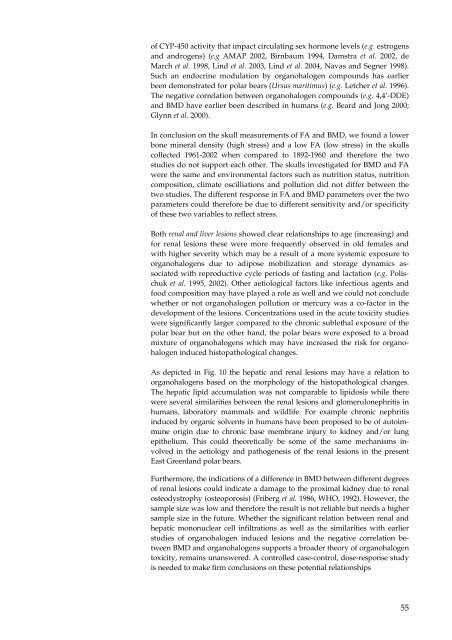Organohalogen concentrations and a gross and histologic ...
Organohalogen concentrations and a gross and histologic ...
Organohalogen concentrations and a gross and histologic ...
Create successful ePaper yourself
Turn your PDF publications into a flip-book with our unique Google optimized e-Paper software.
of CYP-450 activity that impact circulating sex hormone levels (e.g. estrogens<br />
<strong>and</strong> <strong>and</strong>rogens) (e.g AMAP 2002, Birnbaum 1994, Damstra et al. 2002, de<br />
March et al. 1998, Lind et al. 2003, Lind et al. 2004, Navas <strong>and</strong> Segner 1998).<br />
Such an endocrine modulation by organohalogen compounds has earlier<br />
been demonstrated for polar bears (Ursus maritimus) (e.g. Letcher et al. 1996).<br />
The negative correlation between organohalogen compounds (e.g. 4,4’-DDE)<br />
<strong>and</strong> BMD have earlier been described in humans (e.g. Beard <strong>and</strong> Jong 2000;<br />
Glynn et al. 2000).<br />
In conclusion on the skull measurements of FA <strong>and</strong> BMD, we found a lower<br />
bone mineral density (high stress) <strong>and</strong> a low FA (low stress) in the skulls<br />
collected 1961-2002 when compared to 1892-1960 <strong>and</strong> therefore the two<br />
studies do not support each other. The skulls investigated for BMD <strong>and</strong> FA<br />
were the same <strong>and</strong> environmental factors such as nutrition status, nutrition<br />
composition, climate oscilliations <strong>and</strong> pollution did not differ between the<br />
two studies. The different response in FA <strong>and</strong> BMD parameters over the two<br />
parameters could therefore be due to different sensitivity <strong>and</strong>/or specificity<br />
of these two variables to reflect stress.<br />
Both renal <strong>and</strong> liver lesions showed clear relationships to age (increasing) <strong>and</strong><br />
for renal lesions these were more frequently observed in old females <strong>and</strong><br />
with higher severity which may be a result of a more systemic exposure to<br />
organohalogens due to adipose mobilization <strong>and</strong> storage dynamics associated<br />
with reproductive cycle periods of fasting <strong>and</strong> lactation (e.g. Polischuk<br />
et al. 1995, 2002). Other aetiological factors like infectious agents <strong>and</strong><br />
food composition may have played a role as well <strong>and</strong> we could not conclude<br />
whether or not organohalogen pollution or mercury was a co-factor in the<br />
development of the lesions. Concentrations used in the acute toxicity studies<br />
were significantly larger compared to the chronic sublethal exposure of the<br />
polar bear but on the other h<strong>and</strong>, the polar bears were exposed to a broad<br />
mixture of organohalogens which may have increased the risk for organohalogen<br />
induced histopathological changes.<br />
As depicted in Fig. 10 the hepatic <strong>and</strong> renal lesions may have a relation to<br />
organohalogens based on the morphology of the histopathological changes.<br />
The hepatic lipid accumulation was not comparable to lipidosis while there<br />
were several similarities between the renal lesions <strong>and</strong> glomerulonephritis in<br />
humans, laboratory mammals <strong>and</strong> wildlife. For example chronic nephritis<br />
induced by organic solvents in humans have been proposed to be of autoimmune<br />
origin due to chronic base membrane injury to kidney <strong>and</strong>/or lung<br />
epithelium. This could theoretically be some of the same mechanisms involved<br />
in the aetiology <strong>and</strong> pathogenesis of the renal lesions in the present<br />
East Greenl<strong>and</strong> polar bears.<br />
Furthermore, the indications of a difference in BMD between different degrees<br />
of renal lesions could indicate a damage to the proximal kidney due to renal<br />
osteodystrophy (osteoporosis) (Friberg et al. 1986, WHO, 1992). However, the<br />
sample size was low <strong>and</strong> therefore the result is not reliable but needs a higher<br />
sample size in the future. Whether the significant relation between renal <strong>and</strong><br />
hepatic mononuclear cell infiltrations as well as the similarities with earlier<br />
studies of organohalogen induced lesions <strong>and</strong> the negative correlation between<br />
BMD <strong>and</strong> organohalogens supports a broader theory of organohalogen<br />
toxicity, remains unanswered. A controlled case-control, dose-response study<br />
is needed to make firm conclusions on these potential relationships<br />
55

















